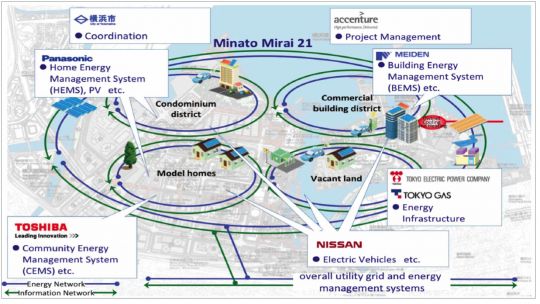GTM Research recently released a smart grid report, The Smart Grid in Asia, 2012-2016: Markets, Technologies and Strategies. This article is the second in a series of perspectives from the report's author on the tremendous smart grid opportunity in Asia; to read part one of this series, click here.
Japan’s ten utilities have turned their attention toward demand-side management in recent years. Now a strong, government-led push is driving the home and building energy management system (HEMS and BEMS) markets out of the research lab and into the product development and deployment stages. With 50 million homes in Japan, the HEMS market alone will be worth well over $2.3 billion by 2015, and the BEMS market will be significantly larger. Three factors influenced the rapid evolution of HEMS and BEMS technologies in Japan: a mature transmission grid, a pressing need to reduce energy demand, and the opportunity to become a world leader in a new technology market.
The Japanese power grid is one of the most efficient grids in the world. Japan has only 17 minutes of blackout time annually (138 minutes in the U.S.), an incredibly low 5.1 percent line loss rate thanks to a $100 billion transmission grid build-out in the 1990s, an average of 41.3 percent thermal efficiency in its thermal power plants (34.1 percent in the U.S.), and nearly 100 percent penetration of digital substations. Japan also has one of the most mature grids in the world. While Japan has just 9 percent of the population of China, it has 50 percent of the substation capacity, 25 percent of the energy consumption, 60 percent of the utility revenues, and 110 percent of the grid assets compared to its gigantic Sino-neighbor. With established grid infrastructure in place since the 1990s, Japan has been able to shift its focus toward optimizing energy management in the past few years, and as of last year, it was forced to make a huge push to meet its goals.
When the Fukushima Daiichi nuclear disaster struck Japan in March 2011, the want for demand-side management technologies became a need, and overnight the Japanese government accelerated its demand-side management and energy efficiency project timelines from 2020 to 2015. What was seen a year ago as a lukewarm smart grid market without a clear focus has since changed into a national, unified focus to reduce energy demand as much as possible. In the past year, most of the major Japanese conglomerates have announced HEMS and BEMS products and pilot studies, including Toyota Housing Corp, DENSO, Fujitsu, Panasonic, Sharp, Toshiba, TEPCO, Tokyo Gas, Osaka Gas, Omron, Hitachi, NTT DoCoMo, and many more.
The market for energy management system (EMS) products has been growing for the past few years, and Japanese firms are preparing to capitalize on the opportunities both domestically and abroad. EMSs are the next step in the logical progression from supply-side management to demand-side management, with Toshiba going so far as to show its vision of the future power grid as a network of EMSs controlling loads from the local to the regional level. Across the globe, there has been a call by utilities for more granular and responsive control of load sources, and the product responses have been different flavors of an EMS, including: demand response, ancillary services, increased appliance energy efficiency, networking load controllers, home area networks, and more solutions.
By the numbers, Japan’s energy consumption is around 25 percent of that of the U.S., which is the second largest electricity consumer in the world after China. Japan, like the U.S., spends around 30 percent of its electrical energy on the residential sector, aiding in the growth of the domestic HEMS market. The commercial & industrial (C&I) market includes office buildings, stores, manufacturing plants, and other large load sources (typically over 15 kilowatts to 50 kilowatts of peak demand). The C&I market is by far the largest market for EMSs, of which a large part is BEMS. The figure below shows why a HEMS market exists in Japan and the U.S., and why BEMS is a larger market overall.
FIGURE: Country Electrical Energy Consumption by Customer Type
Source: The Smart Grid in Asia, 2012-2016: Markets, Technologies and Strategies (GTM Research), EIA
A clear business case exists for reducing load for C&I customers, including quicker return on investments, higher profit margins, larger customers, and a more reliable market. That being said, HEMS is a promising market that includes home automation technologies, and Japanese firms are actively pursuing both markets. An AMI meter connects a HEMS or BEMS to the grid; therefore Japan has mandated a rapid smart meter rollout -- TEPCO will install 17 million AMI meters in homes over the next five years, and another 10 million AMI meters in buildings over the next 10 years. With the communication infrastructure in place, Japan is moving closer to widespread use of HEMS and BEMS.
To facilitate productive competition, the Japan Smart Community Alliance (the Japanese partner of the national Gridwise Alliance) along with the Ministry of Economy, Trade and Industry (METI) and New Energy and Industrial Technology Development Organization (NEDO) have helped form domestic and international standards in HEMS and BEMS technologies. ECHONET is one such example of a communications standard for HEMS. Developing and following open, national and international standards speeds up time to market and the proliferation of HEMS and BEMS products.
Another action Japan took to speed up HEMS and BEMS is the initiation of a series of smart city projects, led by NEDO and organized by Accenture Japan. Between 2009 and 2013, private companies and government are spending $1.64 billion on four smart city pilot projects, with HEMS, BEMS, and community EMS (CEMS) taking up a large chunk of the budget. These smart city pilot projects are expected to expand the smart city concept across Japan, and the nation will become a world leader in smart city technologies, especially HEMS, BEMS, and CEMS. Companies including Toshiba and Panasonic soon may offer “smart city” packages to cities globally, incorporating various HEMS and BEMS solutions into their product lines. The figure below shows one part of a smart city project taking place in Yokohama City.
FIGURE: Smart City Project in Yokohama City, Minato Mirai 21 Area
Source: The Smart Grid in Asia, 2012-2016: Markets, Technologies and Strategies (GTM Research), NEDO
The domestic market for HEMS and BEMS products is growing at a rapid clip, and Japanese firms are poised to develop some of the most advanced EMS technology in the world. While Japan’s market is mature, smart cities and HEMS/BEMS technologies are well suited for both young and mature power grids around the world. In the next five years, expect to see citywide deployments of smart city and EMS technologies in Japan, along with a growing presence of Japanese technologies in world markets.
From localized load control to smart cities, the growth of the energy management system markets in Japan is definitely worth watching.
For more information on Japan's smart grid build-out and The Smart Grid in Asia, 2012-2016: Markets, Technologies and Strategies, visit www.greentechmedia.com/research/report/smart-grid-in-asia-2012-2016.





